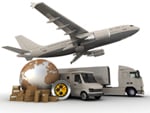While the cargo shipping is beginning to pick up in the United States and exports have increased during the last quarter, Subway has come up with an ingenious use for cargo containers.
The New York Times recognized this ingenuity and on June 16 2010 posted an article about this marvel. Pack n send is posting parts of their article to our website. Our hats are off to Subway for pushing the American Dream to new heights.
Most of the patrons are drawn from an elite group of high-beam artists, namely ironworkers laboring hundreds of feet above the street. The dress code is severe: hard hat, overalls, safety vest and glasses. Security clearance and a union card are a must.
The restaurant, a Subway franchise, opened its door at the top of the steel honeycomb that forms 1 World Trade Center, the skyscraper rising at ground zero. The building will be the city’s tallest when finished in 2013
The sandwich shop is one of four movable “pods” on hydraulic legs sitting on either side of two tower cranes; the other pods house offices, a shanty where workers can change clothes, and bathrooms for men and women.
But despite advances in engineering, materials and safety, when it comes to lunch, ironworkers and other laborers are used to eating the way their literal and proverbial forebears did during the skyscraper boom of the 20th century: out of a lunch bucket, with a plastic cooler doing the job of the old metal pail.
The array of pods cost $3 million, but the contractor hopes to recoup some of the expense in saved time. “The days of eating on top of a steel beam are long gone,” said Bill Grutta, a DCM vice president.
Each pod is made of nine cargo containers welded together and stacked three levels tall. In the dining pod, the Subway sits on the top level.
It is no different from any other Subway, with a kitchen, a walk-in freezer, a service counter and refrigerators for drinks. One level down, there is a heated and air-conditioned lounge with tables and chairs. A compost tank and an evaporator in the bottom container take care of all the solid and liquid waste.
The menu, for now, is instantly recognizable to any connoisseur of the chain. But Mr. Schragger may add ready-to-heat lasagna, burgers, hot dogs and pretzels to the usual $5 footlongs to infuse the shop with a sense of variety. There is also talk of adding Papa John’s pizza. After all, he must cater to the whims of his clientele.
“I don’t think the veggies will be a big seller,” said Mr. Schragger, who owns four other Subways in Manhattan. “I imagine most of the guys will want protein. Philly Cheesesteaks and the Feast.”
The shop is open to ironworkers, who work at the top of the building as it goes up, as well as laborers, concrete workers, electricians and others on the lower floors; at any time more than 1,000 people can be on the job site. But they are not required to eat at the Subway. Business was a little slow Wednesday for what Mr. Schragger called a “soft opening,” but he and DCM are hoping the shop will catch on.
But it is probably the only one whose 500-gallon water tank is replenished weekly by an even larger tanker lifted by a crane. DCM expects — or hopes — that the compost container will not have to be opened until the building is finished. The waterless toilets and urinals are cleaned by negative pressure that pulls the waste into an evaporator that turns much of the sewage into steam.
“As the building goes up,” he said, “the views will be pretty nice. I’m sure it will be one of the most talked-about sites to come have lunch.”

Picture from New York Times article 6/16/2010.
For more mundane uses of cargo containers, please contact pack n send for both cargo shipping and freight preparation at 713 266 1450.





 We pick up & deliver worldwide, as well as in our backyard.
We pick up & deliver worldwide, as well as in our backyard.